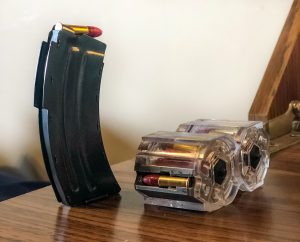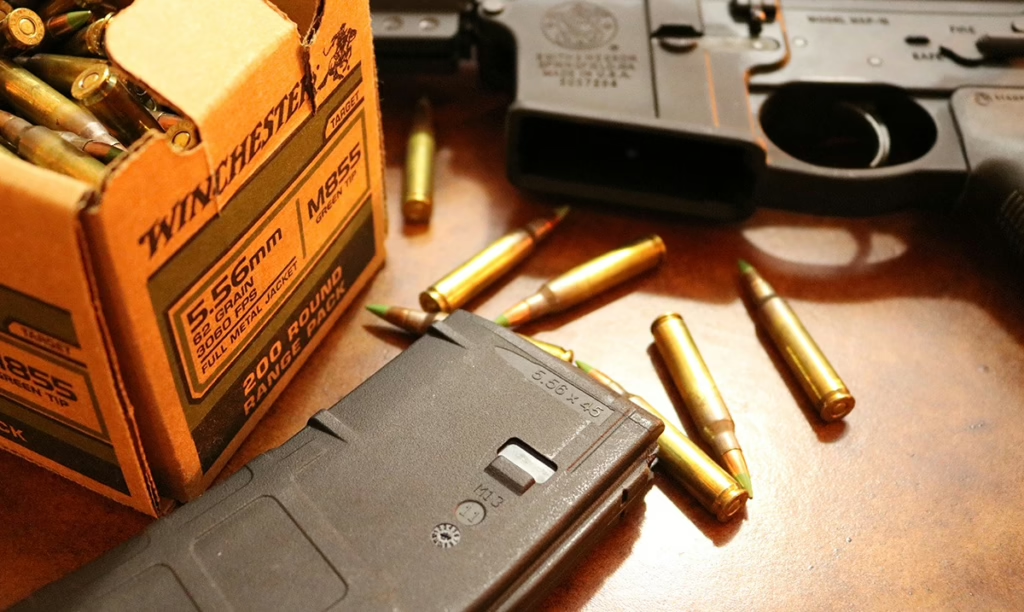
Ah, the magazine, the unsung hero of the firearm. These little gems are what make any gun a “repeating” firearm, and their creation single-handedly changed the face of modern warfare. The magazine, whether detachable or integral to the firearm, stores the cartridges that aren’t loaded in the chamber. It keeps all those “on deck” cartridges ready for action and closest to the place where they’ll do the most good when needed. But before we get into the parts of a magazine and how the magazine functions, let’s take a look at what a magazine isn’t.
A common misnomer associated with the detachable magazine is the word “clip.” A “clip” is not a magazine, rather it is an accessory that some guns use to load a magazine. A clip, or “stripper clip” as it is more commonly called, holds a several cartridges by their rims and the clip is fed into a magazine leaving the rounds in the magazine. Once the user presses the rounds held in the clip off the strip and down into the magazine—stripping the rounds from the clip, thus the name—the clip is removed. A magazine, in contrast, holds the entire cartridge.
 Magazines come in many shapes and sizes. The tube underneath the barrel of any lever-action rifle or pump-action or auto-loading shotgun is a “tubular magazine.” The removable metal- or plastic-sided affair that slides into the handle of a pistol or the underneath of a rifle receiver is a “detachable magazine.” Some bolt-action rifles have a magazine that is part of the receiver. These “non-detachable” or “box magazines” are located underneath the bolt and they sometime have a trapdoor-style hinged floorplate that will release the unfired cartridges for easy and safe unloading of the firearm.
Magazines come in many shapes and sizes. The tube underneath the barrel of any lever-action rifle or pump-action or auto-loading shotgun is a “tubular magazine.” The removable metal- or plastic-sided affair that slides into the handle of a pistol or the underneath of a rifle receiver is a “detachable magazine.” Some bolt-action rifles have a magazine that is part of the receiver. These “non-detachable” or “box magazines” are located underneath the bolt and they sometime have a trapdoor-style hinged floorplate that will release the unfired cartridges for easy and safe unloading of the firearm.
What do all these magazine types have in common? Springs. Tension is the key to keeping a cartridge in the proper place for loading into the firearm’s chamber. Some magazines use a coil spring, some a leaf-style spring, but they all use some sort of spring to push the next available cartridge into place, ready to be chambered.
Tubular magazines use a spring alone to keep the cartridges ready, while the box-style magazines use a cartridge “follower.” This little piece of metal is designed to push the cartridge upward, without holding it, yet without letting it flop all over the place, for this cartridge at the top of the magazine needs to be in the proper location to be picked up by the bolt or slide of the firearm and sent on to the chamber as the bolt moves forward and closes.

Shown are two magazines for 22 lr long rifles. The single stack magazine (left) is for a Savage Mark II bolt action rimfire rifle and the coiled dual magazine (right) is for a Ruger 10-22.
You may hear some magazines referred to as either “single stack” or “double stack.” Simply put, a single-stack magazine aligns its cartridges one on top of the other in a relatively straight vertical line; the inner magazine width from side to side is roughly the same dimension as the cartridge. A good example of a single-stack magazine is the one found in the Colt 1911 and its many current day variations. A double-stack magazine, in contrast, has a wider inner magazine dimension, because the cartridges are stacked in a staggered fashion to provide more capacity. Handgun models you might be familiar with that utilize a double-stack magazine would be the many produced by Glock, the SIG Sauer P226 in 9mm or .45 ACP, and the wide-frame versions of the Colt 1911developed by the company STI International and known as 2011s, guns popular with IPSC and 3-Gun competitors because of the large number of rounds many of them hold. The larger cartridges are most often loaded in a single stack fashion, while the slimmer cartridges fit just fine in a double stack fashion without making the magazine obtrusive.
There is great debate on whether it’s good for your magazines to leave them loaded when the gun is in long-term storage such as, perhaps, a self-defense gun that doesn’t get shot very often (and, yes, you absolutely should shoot your designated self-defense guns often, but it’s also a reality that many people don’t). I’m of the camp who believe that, if your magazine is detachable, you leave them unloaded. Still, I have to admit that it is perfectly fine to leave cartridges in a magazine, provided the firearms and magazines are stored safely and responsibly; if you needed a gun in a life or death situation, you almost certainly do not want to think about having to insert a magazine (possibly in the dark) or waste what could be crucial seconds putting a magazine in your gun when lives are at stake, but those are situations for another discussion. Bottom line, if you don’t have a need to keep your magazines loaded, store them unloaded and reduce the chances of their springs losing their elasticity due to prolonged compression.





